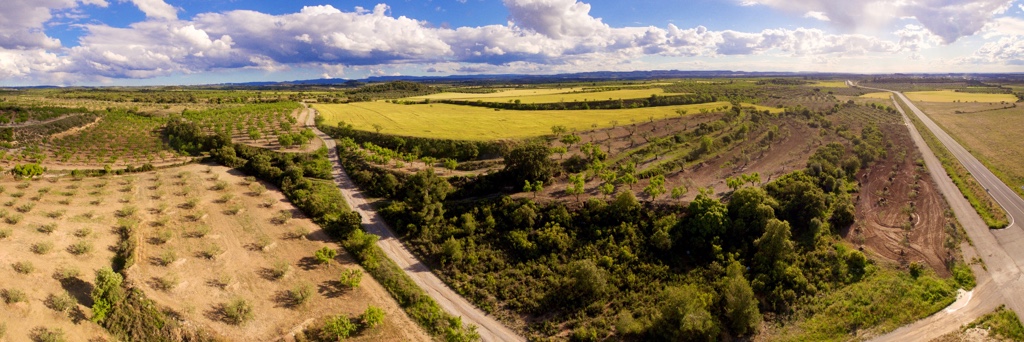The SPAB area of the drylands of Belianes-Preixana is formed of three subunits:
The central nucleus is a large plain originating from the gravel of the alluvial cone of the river Corb, the vertex of which is in Belianes and extends westwards and northwards forming a large cone with an imperceptible slope. The Urgell canal, which constitutes the north-western limit of the SPAB, adapts to this relief forming an arc between Bellpuig and the Pletes mountain range. The whole surface is used for farming, of the dryland variety or with spring irrigation, growing mainly winter cereals and, to a lesser extent, almond trees, olive trees and vineyards. The field terraces sustain some large trees, such as holm oaks and hackberry trees, as well as some old almond trees. On summer evenings, when the green of the trees contrasts with the yellow of the stalks, it could be mistaken for the savannah.
In the easternmost point, east of Preixana, the plain is dotted with small mountains from east to west. The most remarkable and panoramic of these mountains is that of Montalbà, in Vilagrassa. The tabular reliefs are linked to areas depressed by glaciers that have a significant slope, which is why they are not cultivated and maintain a coating of scrub and esparto grass caused by the degradation of the old holm oaks.
In the westernmost point, to the west of the Pletes mountain range, the relief, which is more severe, makes a transition to a platform of kermes oaks. There are extensive plateaus separated by well enclosed valleys. The upper plain of the plateaus, with skeletal soil that is not suitable for cultivation, is occupied by maquis dominated by kermes oak (Montplà mountain range).
FLORA AND VEGETATION
More than any other type of vegetation, holm oaks are to be found in profusion throughout the area. From this primitive forest there are some isolated holm oak stumps, accompanied by large bushes such as black hawthorn, Mediterranean buckthorn, kermes oak or common yellow jasmine and the corresponding undergrowth plants such as sheep fescue, madwort, or common madder.
Some Aleppo pines can also be found, representing the initial stages of the reconstitution of the wood.
The degradation of the wood from over cutting and grazing on the holm oak has given rise to the formation of calcicolous scrub, mostly lacking in rosemary.
Towards the southeast (the Fonta de Preixana hills and the Belianes and Arbeca mountain ranges) there is an increase in the Mediterranean nature of the climate (less fog and cooler summers) and calcicolous scrub formed of rosemary and slim-leaved flax with sage-leaved cistus grow, rosemary being the most dominant plant.
The most extensive areas of vegetation are in the Montplà mountain range, on the borders of Arbeca and Belianes, where there are large garrigues dominated by kermes oak.
The nitro-halophilic scrubland made up of Mediterranean saltwort, white wormwood and camphor fume, has a significant ecological function in covering unfavourable and uncultivated areas due to a clayey, saline and highly nitrogenous substrate.
The most remarkable natural herbaceous formation in the area is esparto grass, dominated by albardine and accompanied by several species of the genus Stipa.
The vegetation that accompanies the dryland crops is the most widespread in the area. In the cereal fields, the dominant community is formed of Hypecoum imberbe and Roemeria hybrida, dominated by the common poppy, which forms spectacular red sheets over fields that have not been treated with herbicides. There is also a set of grasses that are difficult to eradicate due to their metabolic similarity to the cultivated cereal, such as great brome, brome grass and common wild oat.
The areas of woody crops are dominated by the community of white wall rocket a grass that dresses the fields in white throughout the winter.
WILDLIFE
In terms of invertebrates, due to their abundance and tendency to significant decline, it is worth mentioning the tarantula, the scolopendra and the only species of solifugid inhabiting Spain and Portugal, Gluvia dorsalis.
As for amphibians, the most remarkable is the natterjack toad, which is able to bury itself the drylands and is therefore protected by a mucous layer and spends long periods in aestivation-hibernation, waiting for an abundant rainfall, which it makes use of for eating and breeding in the large puddles it creates.
In terms of reptiles, the most profuse include the ladder snake, the Montpellier snake, the ocellated lizard, the large psammodromus, the Spanish psammodromus, the Iberian wall lizard and the gecko.
BIRDS (ORNITHOLOGY)
The abundance and diversity of steppe birds in the area is what has led to the declaration of a special protection area (SPAB). These drylands are a nesting area for more than 30 species, added to which are those that only spend the winter or stop to feed while on their migration route.
Among the nesting birds, it's worth mentioning the little bustard, the European roller, the stone-curlew, the calandra lark, the bee-eater, Iberian green woodpecker, the greater short-toed lark, the greater spotted cuckoo, the red necked nightjar, the crested lark, the Thekla's lark, the corn bunting, the black-eared wheatear, the Eurasian tree sparrow and the woodchat shrike, as well as a group of birds of prey including the Montagu's harrier, the lesser kestrel, the common kestrel, the common buzzard, the short-toed snake eagle, the northern goshawk, the little owl and the barn owl.
